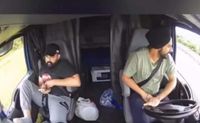On August 12, 2025, a devastating crash on Florida’s Turnpike near Fort Pierce claimed the lives of three South Florida residents, igniting a fierce political storm between the federal government and California officials. The incident, involving a semi-truck driven by Harjinder Singh—an undocumented immigrant from India—has become a flashpoint in the national debate over immigration policy and public safety.
The Florida Highway Patrol (FHP) reported that the crash occurred shortly before 3 p.m. near mile marker 171. Singh, 28, was behind the wheel of a semi-truck hauling a trailer when he attempted an illegal U-turn at an “Official Use Only Turn Around.” According to FHP, the maneuver blocked all northbound lanes, leaving a Chrysler Town & Country minivan, traveling in the inside lane, with no chance to avoid a collision. The minivan became wedged beneath the trailer, and all three occupants—a 30-year-old man from Florida City, a 37-year-old woman from Pompano Beach, and a 54-year-old man from Miami—were killed. Two died at the scene, while the third succumbed to injuries at the hospital.
Singh and a 25-year-old passenger from Yuba City, California, were uninjured. The FHP quickly identified Singh as the driver and began piecing together a troubling history that would soon reverberate far beyond the crash site.
In the days following the accident, authorities arrested Singh in Stockton, California, after learning he had flown to Sacramento the day after the crash. He was taken into custody on August 16, 2025, and charged with three counts of vehicular homicide. According to the U.S. Marshals Service and U.S. Immigration and Customs Enforcement (ICE), Singh had entered the United States illegally in 2018, crossing the southern border from Mexico. He was detained within two days, claimed fear of returning to India, and was released on a $5,000 immigration bond pending proceedings that have remained unresolved ever since.
The controversy intensified when it was revealed that Singh had obtained a Commercial Driver’s License (CDL) from the California Department of Motor Vehicles (DMV) despite lacking legal status. California’s Assembly Bill 60 (AB 60), enacted in 2015, allows undocumented immigrants to apply for a driver’s license if they can provide proof of identity and state residency. These licenses are marked “not for federal identification,” but, according to the California DMV, a lawful presence is still required for commercial licenses like the one Singh held. How Singh obtained his CDL remains unclear, with officials on both sides of the political aisle demanding answers.
The Department of Homeland Security (DHS) and Florida officials wasted no time pointing fingers. DHS Secretary Kristi Noem called the crash “a gut-wrenching tragedy which should have never happened,” according to FOX 35 Orlando. In a statement released August 19, DHS blamed California Governor Gavin Newsom’s administration: “Three innocent people were killed in Florida because Gavin Newsom’s California DMV issued an illegal alien a Commercial Driver’s License—this state of governance is asinine.” The statement continued, “How many more innocent people have to die before Gavin Newsom stops playing games with the safety of the American public? We pray for the victims and their families. Secretary Noem and DHS are working around the clock to protect the public and get these criminal illegal aliens out of America.”
Tricia McLaughlin, DHS Assistant Secretary, echoed the condemnation, directly criticizing California’s policies and raising alarm about sanctuary jurisdictions. The White House joined in, accusing Newsom of being a “criminal illegal alien sympathizer” whose “reckless policies put the lives of American citizens at risk every single day,” as reported by NDTV.
California officials, however, pushed back hard. Newsom’s press office pointed out that Singh entered the U.S. illegally in 2018—when Donald Trump was president. “.@grok, who was President in 2018?” the office posted on social media, highlighting the timeline and shifting some responsibility back to federal authorities. The governor’s office further noted that California law requires proof of lawful presence for commercial licenses, raising questions about how Singh slipped through the cracks.
In a prepared statement, Dave Kerner, Executive Director of the Florida Department of Highway Safety and Motor Vehicles, called Singh’s actions “shocking and criminal.” He added, “Three people lost their lives as a result of his recklessness, and countless friends and family members will experience the pain of their loss forever.” Kerner underscored that Singh “will no longer be able to damage and destroy the lives of Floridians and visitors. At the conclusion of his state charges, he will be deported.”
The Department of Justice also weighed in, with Attorney General Pamela Bondi declaring, “The American people have suffered the deadly consequences of illegal immigration for FAR TOO LONG. The DOJ will prosecute every illegal alien and fight against all sanctuary jurisdictions enabling the invasion of our country.”
Meanwhile, ICE issued an immigration detainer for Singh on August 16 to ensure he remains in custody after state prosecution. “This detainer ensures he will be transferred to ICE custody the moment his criminal case concludes,” DHS stated, aiming to prevent Singh from “slipping back onto America’s streets.”
The crash and its aftermath have fueled heated debate over immigration enforcement, state versus federal authority, and the responsibilities of sanctuary jurisdictions. Supporters of stricter immigration laws argue that California’s AB 60 and similar measures undermine public safety and federal efforts to control illegal immigration. They point to this tragedy as evidence that granting licenses to undocumented immigrants can have deadly consequences.
On the other hand, California officials and immigrant rights advocates contend that AB 60 improves road safety by ensuring drivers are tested, insured, and accountable—regardless of immigration status. They argue that the real problem lies in systemic federal failures to resolve immigration cases efficiently and prevent unauthorized entries at the border. As Newsom’s office highlighted, Singh’s immigration proceedings had dragged on for years without resolution, despite his initial arrest in 2018.
The incident has also reignited the long-standing feud between Governor Newsom and former President Trump, with both sides using the tragedy to bolster their respective arguments on immigration and public safety. As the investigation continues, questions remain about how Singh was able to obtain a CDL, whether procedural lapses occurred at the DMV, and what steps can be taken to prevent similar tragedies in the future.
For now, the families of the victims—whose lives were cut short in a matter of seconds—are left to mourn, while the nation grapples with the broader implications of a crash that has become much more than just a traffic accident. The debate over immigration, state authority, and public safety shows no signs of abating, as policymakers and communities search for answers—and accountability—amid the heartbreak.


